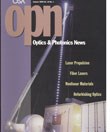
January 1999 Issue
- Lightcraft Propulsion Technology for Low-Cost Access to Space
- High-power fiber lasers and amplifiers
- Advances in Bulk Inorganic Nonlinear Optical Materials
- Hamlet's Optical Parable: To Refurbish or Not to Refurbish Old Lenses? Cost is the Question
- Creating Legible Transparencies
- First-order Temporal Coherence in Classical Optics
- Wide-angle Soft Focus Photographic Lens
- Browse all Issues
Feature Articles
Lightcraft Propulsion Technology for Low-Cost Access to Space
THE IMAGE OF LASERS PROPELLING ROCKETS INTO SPACE, A CONCEPT PREVIOUSLY RESERVED FOR THE PAGES OF SCIENCE FICTION NOVELS, MAY ONE DAY BECOME A REALITY. THIS ARTICLE LOOKS AT THE VIABILITY OF SUCH AN ENDEAVOR AND EFFORTS UNDERWAY TO BRING IT ABOUT.
by Patrick Carrick, Franklin Mead Jr., Leik MyraboHigh-power fiber lasers and amplifiers
The development of a new fiber laser design—the double-clad fiber laser—has impacted the telecommunications, graphic arts, medical technologies, and materials processing industries. This article looks at the properties of these relatively new devices and explains their impact on current technologies.
by David J. DiGiovanni and Martin H. MuendelAdvances in Bulk Inorganic Nonlinear Optical Materials
Rare-earth calcium oxyborate crystals could potentially break the production bottleneck of nonlinear optical materials. Chai looks closely at how these crystals are made, the properties they possess, and a potential display application.
by Bruce H.T. ChaiHamlet's Optical Parable: To Refurbish or Not to Refurbish Old Lenses? Cost is the Question
So you have an older optical system that would be perfect for a new job if only the lens were changed in some way. Is refurbishing an economical alternative to manufacturing a new assembly? Kane provides some guidance.
by Gordon KaneCreating Legible Transparencies
How often have you found yourself looking forward to a talk at a conference, and then the lights dim, the speaker begins, and you can't read his transparencies? As the presentation continues, you find yourself squinting, increasingly trying to decipher what's being shown. After a while, you just give up, realize it's not worth the effort, and sit back and listen as the speaker presents and discusses each congested transparency. As it turns out, the talk is far from the enlightening and educational experience you'd hoped for. Until recently, transparencies were either drawn by hand or created by an artist. The artist was familiar with the different font, point size, and layout requirements of various publications, and they also knew the rules of good transparency design. As people have started to generate their own graphics, the readability of conference transparencies has decreased dramatically. Here are some steps to ensure transparency readability.
by Carol CavanaghFirst-order Temporal Coherence in Classical Optics
A truly monochromatic beam of light, if it ever existed, would be perfectly coherent. Such a beam could be split into two parts and each part propagated over an arbitrary distance. When the parts were finally brought together and mixed, no matter how different the two path lengths may have been, the resulting waveform would exhibit constructive and destructive interference in the form of bright and dark fringes. The coherence length of a monochromatic beam is therefore infinite, in the sense that the path length difference can be as large as desired, without hampering one's ability to create interference patterns.
by Masud Mansuripur and Ewan M. WrightWide-angle Soft Focus Photographic Lens
When a lens designer sets out to design a photographic objective the usual goal is to produce the sharpest possible lens by optimally minimizing all aberrations. However, this is not the case with lenses intended for portrait photography. A well-corrected lens will ruthlessly reveal all facial blemishes and wrinkles, and many people find this disturbing. As Arthur Cox put it, "portrait work, especially commercial or professional portrait work, is as much subtle flattery as photography." The best alternative is to use a special soft focus lens having a large amount of spherical aberration. A point image produced by such a lens will consist of a fairly small core surrounded by a large halo. And, since this effect is stable in the presence of moderate amounts of defocus, the depth-of-field is larger than that of a well-corrected lens. The small core ensures that high-contrast, fine detail remains visible, while the large halo tends to blend away blemishes and wrinkles.
by J. Brian Caldwell
![Infinity Mirrored Room– Brilliance of the Souls 2014 by artist Yayoi Kusama. [© YAYOI KUSAMA]](https://opnmedia.blob.core.windows.net/$web/opn/media/images/articles/2024/0724/departments/202407-cover-web.jpg?ext=.jpg)
![An experimental scheme demonstrated by researchers at Princeton and Yale universities, USA, can convert physical noise into errors that can be corrected more easily. [F. Wojciechowski, Princeton University]](https://opnmedia.blob.core.windows.net/$web/opn/media/images/articles/2024/0624/departments/202406-cover-web.jpg?ext=.jpg)
